Note
Go to the end to download the full example code.
JDOT Regressor and Classifier examples
This example shows how to use the JDOTRegressor [10] to learn a regression model from source to target domain on a simple conditional shift 2D example. We use a simple Kernel Ridge Regression (KRR) as base estimator.
We compare the performance of the KRR on the source and target domain, and the JDOTRegressor on the same task and illustrate the learned decision boundary and the OT plan between samples estimated by JDOT.
# Author: Remi Flamary
#
# License: BSD 3-Clause
# sphinx_gallery_thumbnail_number = 4
import matplotlib.pyplot as plt
import numpy as np
from sklearn.kernel_ridge import KernelRidge
from sklearn.linear_model import LogisticRegression
from sklearn.metrics import mean_squared_error
from sklearn.svm import SVC
from skada import JDOTClassifier, JDOTRegressor, source_target_split
from skada.datasets import make_shifted_datasets
Generate conditional shift regression dataset and plot it
We generate a simple 2D conditional shift dataset.
X, y, sample_domain = make_shifted_datasets(
n_samples_source=20,
n_samples_target=20,
shift="conditional_shift",
noise=0.3,
label="regression",
random_state=42,
)
y = (y - y.mean()) / y.std()
Xs, Xt, ys, yt = source_target_split(X, y, sample_domain=sample_domain)
plt.figure(1, (10, 5))
plt.subplot(1, 2, 1)
plt.scatter(Xs[:, 0], Xs[:, 1], c=ys, label="Source")
plt.title("Source data")
ax = plt.axis()
plt.subplot(1, 2, 2)
plt.scatter(Xt[:, 0], Xt[:, 1], c=yt, label="Target")
plt.title("Target data")
plt.axis(ax)
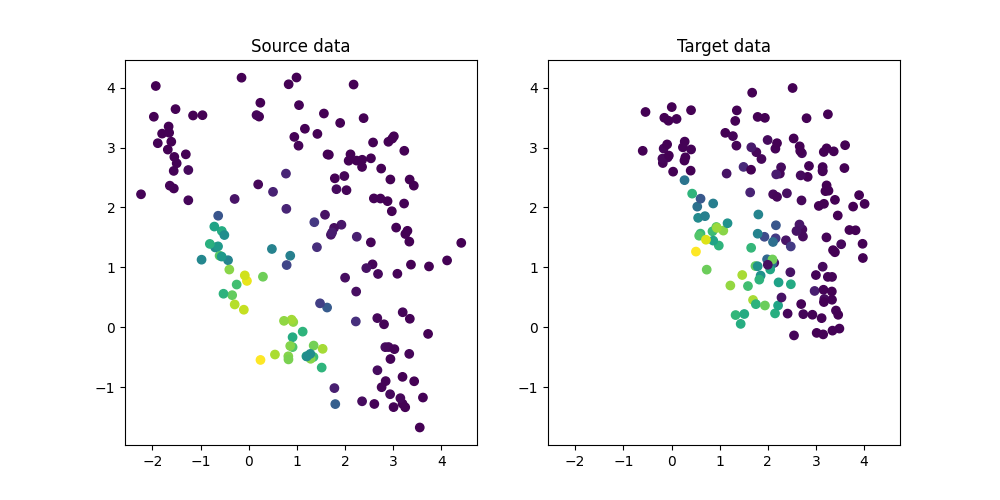
(np.float64(-2.570318895725525), np.float64(4.744989537549497), np.float64(-1.9610814126500358), np.float64(4.45933195939893))
Train a regressor on source data
We train a simple Kernel Ridge Regression (KRR) on the source domain and evaluate its performance on the source and target domain. Performance is much lower on the target domain due to the shift. We also plot the decision boundary learned by the KRR.
clf = KernelRidge(kernel="rbf", alpha=0.5)
clf.fit(Xs, ys)
# Compute accuracy on source and target
ys_pred = clf.predict(Xs)
yt_pred = clf.predict(Xt)
mse_s = mean_squared_error(ys, ys_pred)
mse_t = mean_squared_error(yt, yt_pred)
print(f"MSE on source: {mse_s:.2f}")
print(f"MSE on target: {mse_t:.2f}")
XX, YY = np.meshgrid(np.linspace(ax[0], ax[1], 100), np.linspace(ax[2], ax[3], 100))
Z = clf.predict(np.c_[XX.ravel(), YY.ravel()]).reshape(XX.shape)
plt.figure(2, (10, 5))
plt.subplot(1, 2, 1)
plt.scatter(Xs[:, 0], Xs[:, 1], c=ys, label="Prediction")
plt.imshow(Z, extent=(ax[0], ax[1], ax[2], ax[3]), origin="lower", alpha=0.5)
plt.title(f"KRR Prediction on source (MSE={mse_s:.2f})")
plt.axis(ax)
plt.subplot(1, 2, 2)
plt.scatter(Xt[:, 0], Xt[:, 1], c=yt, label="Prediction")
plt.imshow(Z, extent=(ax[0], ax[1], ax[2], ax[3]), origin="lower", alpha=0.5)
plt.title(f"KRR Prediction on target (MSE={mse_t:.2f})")
plt.axis(ax)
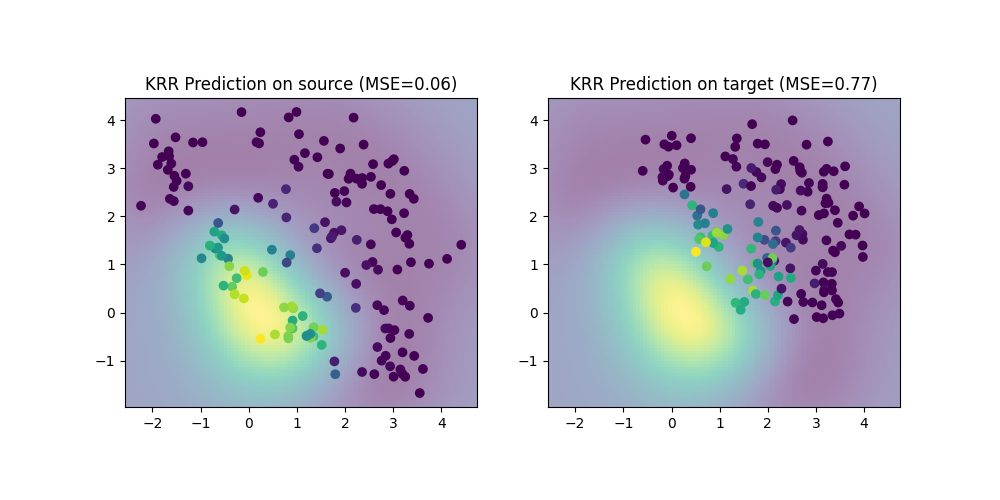
MSE on source: 0.06
MSE on target: 0.77
(np.float64(-2.570318895725525), np.float64(4.744989537549497), np.float64(-1.9610814126500358), np.float64(4.45933195939893))
Train with JDOT regressor
We now use the JDOTRegressor to learn a regression model from source to target domain. We use the same KRR as base estimator. We compare the performance of JDOT on the source and target domain, and illustrate the learned decision boundary of JDOT. Performance is much better on the target domain than with the KRR trained on source.
jdot = JDOTRegressor(base_estimator=KernelRidge(kernel="rbf", alpha=0.5), alpha=0.01)
jdot.fit(X, y, sample_domain=sample_domain)
ys_pred = jdot.predict(Xs)
yt_pred = jdot.predict(Xt)
mse_s = mean_squared_error(ys, ys_pred)
mse_t = mean_squared_error(yt, yt_pred)
Zjdot = jdot.predict(np.c_[XX.ravel(), YY.ravel()]).reshape(XX.shape)
print(f"JDOT MSE on source: {mse_s:.2f}")
print(f"JDOT MSE on target: {mse_t:.2f}")
plt.figure(3, (10, 5))
plt.subplot(1, 2, 1)
plt.scatter(Xs[:, 0], Xs[:, 1], c=ys, label="Prediction")
plt.imshow(Zjdot, extent=(ax[0], ax[1], ax[2], ax[3]), origin="lower", alpha=0.5)
plt.title(f"JDOT Prediction on source (MSE={mse_s:.2f})")
plt.axis(ax)
plt.subplot(1, 2, 2)
plt.scatter(Xt[:, 0], Xt[:, 1], c=yt, label="Prediction")
plt.imshow(Zjdot, extent=(ax[0], ax[1], ax[2], ax[3]), origin="lower", alpha=0.5)
plt.title(f"JDOT Prediction on target (MSE={mse_t:.2f})")
plt.axis(ax)
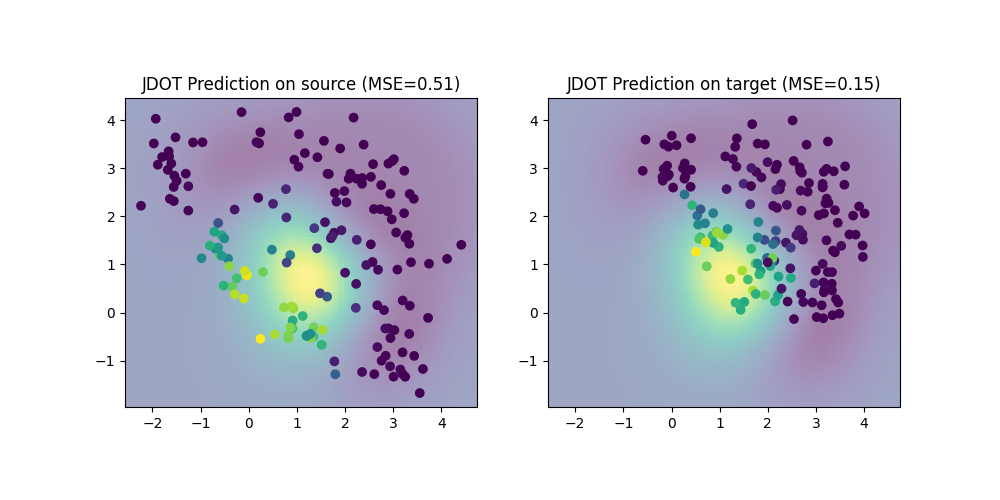
JDOT MSE on source: 0.51
JDOT MSE on target: 0.15
(np.float64(-2.570318895725525), np.float64(4.744989537549497), np.float64(-1.9610814126500358), np.float64(4.45933195939893))
Illustration of the OT plan
We illustrate the OT plan between samples estimated by JDOT. We plot the OT plan between the source and target samples. We can see that the OT plan is able to align the source and target samples while preserving the label.
T = jdot.sol_.plan
T = T / T.max()
plt.figure(4, (5, 5))
plt.scatter(Xs[:, 0], Xs[:, 1], c="C0", label="Source", alpha=0.7)
plt.scatter(Xt[:, 0], Xt[:, 1], c="C1", label="Target", alpha=0.7)
for i in range(Xs.shape[0]):
for j in range(Xt.shape[0]):
if T[i, j] > 0.01:
plt.plot(
[Xs[i, 0], Xt[j, 0]], [Xs[i, 1], Xt[j, 1]], "k", alpha=T[i, j] * 0.8
)
plt.legend()
plt.title("OT plan between source and target")
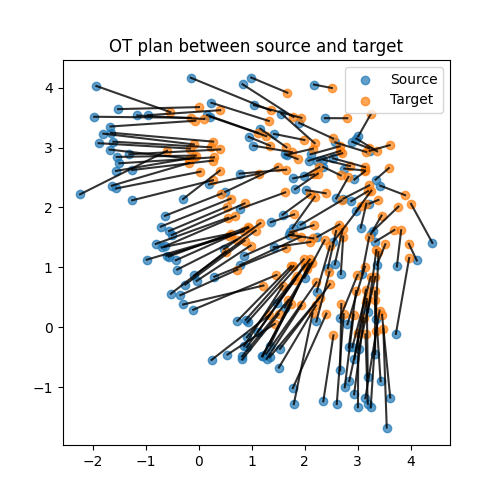
Text(0.5, 1.0, 'OT plan between source and target')
Generate conditional shift classification dataset and plot it
We generate a simple 2D conditional shift dataset.
X, y, sample_domain = make_shifted_datasets(
n_samples_source=20,
n_samples_target=20,
shift="conditional_shift",
noise=0.2,
label="multiclass",
random_state=42,
)
Xs, Xt, ys, yt = source_target_split(X, y, sample_domain=sample_domain)
plt.figure(5, (10, 5))
plt.subplot(1, 2, 1)
plt.scatter(Xs[:, 0], Xs[:, 1], c=ys, cmap="tab10", vmax=9, label="Source")
plt.title("Source data")
ax = plt.axis()
plt.subplot(1, 2, 2)
plt.scatter(Xt[:, 0], Xt[:, 1], c=yt, cmap="tab10", vmax=9, label="Target")
plt.title("Target data")
plt.axis(ax)
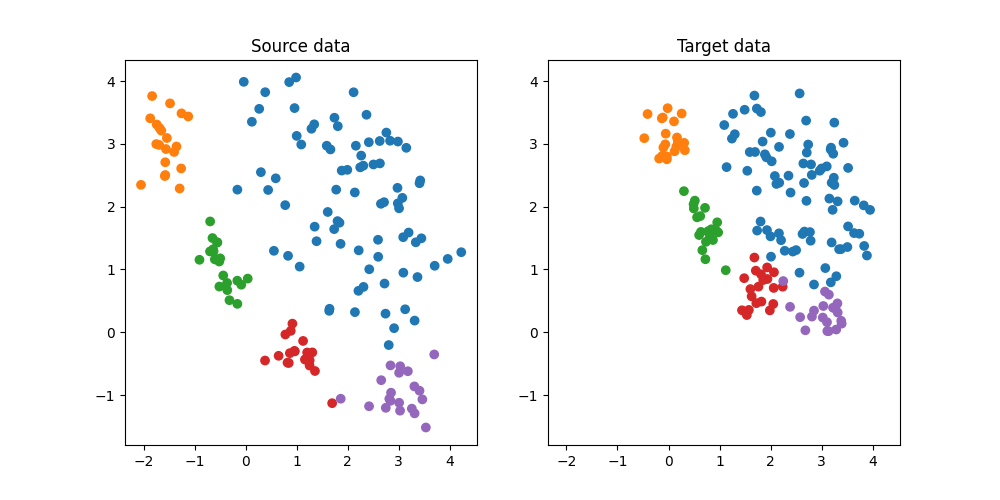
(np.float64(-2.3676169789533272), np.float64(4.53817259426296), np.float64(-1.7964573229829714), np.float64(4.336863129384494))
Train a classifier on source data
We train a simple SVC classifier on the source domain and evaluate its performance on the source and target domain. Performance is much lower on the target domain due to the shift. We also plot the decision boundary
clf = LogisticRegression()
clf.fit(Xs, ys)
# Compute accuracy on source and target
ys_pred = clf.predict(Xs)
yt_pred = clf.predict(Xt)
acc_s = (ys_pred == ys).mean()
acc_t = (yt_pred == yt).mean()
print(f"Accuracy on source: {acc_s:.2f}")
print(f"Accuracy on target: {acc_t:.2f}")
XX, YY = np.meshgrid(np.linspace(ax[0], ax[1], 100), np.linspace(ax[2], ax[3], 100))
Z = clf.predict(np.c_[XX.ravel(), YY.ravel()]).reshape(XX.shape)
plt.figure(6, (10, 5))
plt.subplot(1, 2, 1)
plt.scatter(Xs[:, 0], Xs[:, 1], c=ys, cmap="tab10", vmax=9, label="Prediction")
plt.imshow(
Z,
extent=(ax[0], ax[1], ax[2], ax[3]),
origin="lower",
alpha=0.5,
cmap="tab10",
vmax=9,
)
plt.title(f"SVC Prediction on source (ACC={acc_s:.2f})")
plt.subplot(1, 2, 2)
plt.scatter(Xt[:, 0], Xt[:, 1], c=yt, cmap="tab10", vmax=9, label="Prediction")
plt.imshow(
Z,
extent=(ax[0], ax[1], ax[2], ax[3]),
origin="lower",
alpha=0.5,
cmap="tab10",
vmax=9,
)
plt.title(f"SVC Prediction on target (ACC={acc_t:.2f})")
plt.axis(ax)
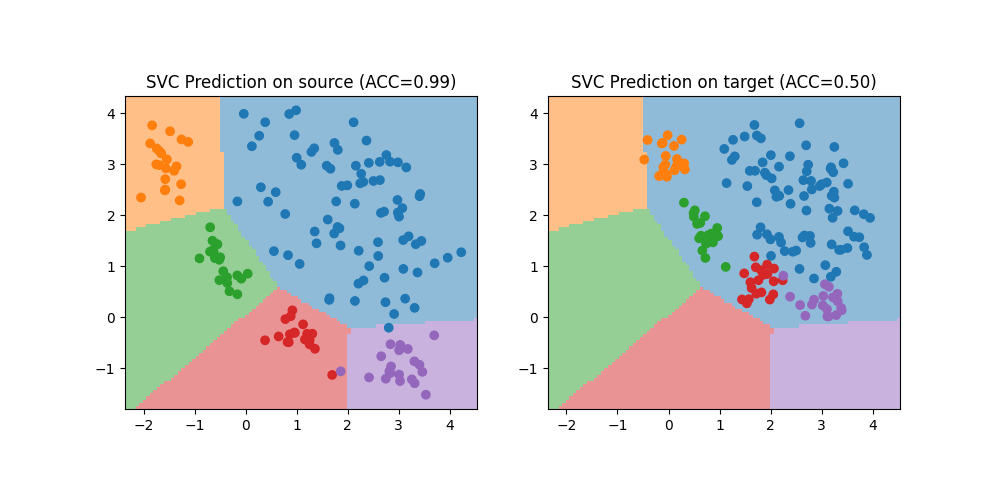
Accuracy on source: 0.99
Accuracy on target: 0.50
(np.float64(-2.3676169789533272), np.float64(4.53817259426296), np.float64(-1.7964573229829714), np.float64(4.336863129384494))
Train with JDOT classifier
We now use the JDOTClassifier to learn a classification model from source to target domain. We use the same SVC as base estimator. We compare the performance of JDOT on the source and target domain, and illustrate the learned decision boundary of JDOT. Performance is much better on the target domain than with the SVC trained on source.
jdot = JDOTClassifier(LogisticRegression(), verbose=True)
jdot.fit(X, y, sample_domain=sample_domain)
ys_pred = jdot.predict(Xs)
yt_pred = jdot.predict(Xt)
acc_s = (ys_pred == ys).mean()
acc_t = (yt_pred == yt).mean()
print(f"JDOT Accuracy on source: {acc_s:.2f}")
print(f"JDOT Accuracy on target: {acc_t:.2f}")
XX, YY = np.meshgrid(np.linspace(ax[0], ax[1], 100), np.linspace(ax[2], ax[3], 100))
Z = jdot.predict(np.c_[XX.ravel(), YY.ravel()]).reshape(XX.shape)
plt.figure(7, (10, 5))
plt.subplot(1, 2, 1)
plt.scatter(Xs[:, 0], Xs[:, 1], c=ys, cmap="tab10", vmax=9, label="Prediction")
plt.imshow(
Z,
extent=(ax[0], ax[1], ax[2], ax[3]),
origin="lower",
alpha=0.5,
cmap="tab10",
vmax=9,
)
plt.title(f"JDOT reglog on source (ACC={acc_s:.2f})")
plt.subplot(1, 2, 2)
plt.scatter(Xt[:, 0], Xt[:, 1], c=yt, cmap="tab10", vmax=9, label="Prediction")
plt.imshow(
Z,
extent=(ax[0], ax[1], ax[2], ax[3]),
origin="lower",
alpha=0.5,
cmap="tab10",
vmax=9,
)
plt.title(f"JDOT reglog on target (ACC={acc_t:.2f})")
plt.axis(ax)
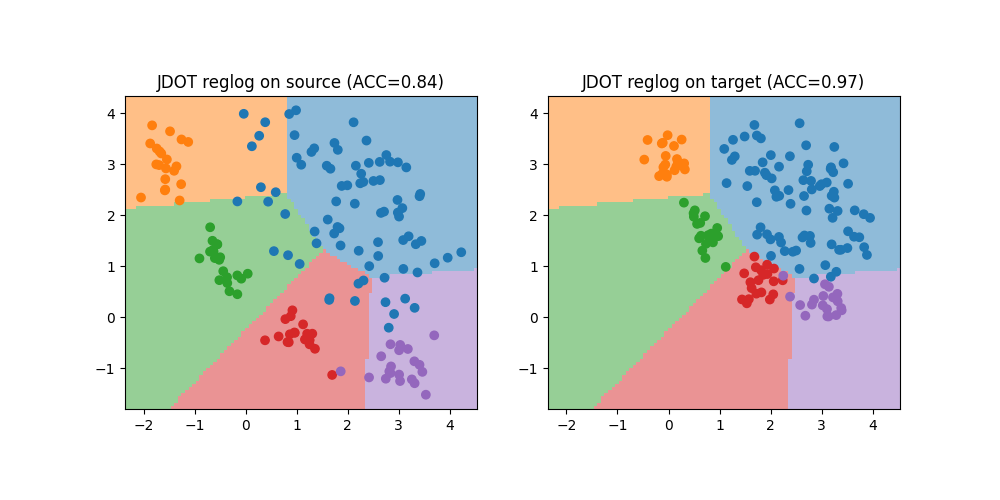
iter=0, loss_ot=5.075493682966016, loss_tgt_labels=0.2298312955459269
iter=1, loss_ot=0.18530735809550555, loss_tgt_labels=0.2142044526662074
iter=2, loss_ot=0.182799418703954, loss_tgt_labels=0.2142044526662074
JDOT Accuracy on source: 0.84
JDOT Accuracy on target: 0.97
(np.float64(-2.3676169789533272), np.float64(4.53817259426296), np.float64(-1.7964573229829714), np.float64(4.336863129384494))
Train with JDOT classifier with SVC
We now use the JDOTClassifier with a support vector classifier as base estimator to learn a classification model from source to target domain. Note that in this case it is necessary to change the metric from the default 'multinomial' to 'hinge' to match the hinge loss used by the SVC.
jdot = JDOTClassifier(SVC(kernel="rbf", C=1), metric="hinge")
jdot.fit(X, y, sample_domain=sample_domain)
ys_pred = jdot.predict(Xs)
yt_pred = jdot.predict(Xt)
acc_s = (ys_pred == ys).mean()
acc_t = (yt_pred == yt).mean()
print(f"JDOT Accuracy on source: {acc_s:.2f}")
print(f"JDOT Accuracy on target: {acc_t:.2f}")
XX, YY = np.meshgrid(np.linspace(ax[0], ax[1], 100), np.linspace(ax[2], ax[3], 100))
Z = jdot.predict(np.c_[XX.ravel(), YY.ravel()]).reshape(XX.shape)
plt.figure(8, (10, 5))
plt.subplot(1, 2, 1)
plt.scatter(Xs[:, 0], Xs[:, 1], c=ys, cmap="tab10", vmax=9, label="Prediction")
plt.imshow(
Z,
extent=(ax[0], ax[1], ax[2], ax[3]),
origin="lower",
alpha=0.5,
cmap="tab10",
vmax=9,
)
plt.title(f"JDOT SVC on source (ACC={acc_s:.2f})")
plt.subplot(1, 2, 2)
plt.scatter(Xt[:, 0], Xt[:, 1], c=yt, cmap="tab10", vmax=9, label="Prediction")
plt.imshow(
Z,
extent=(ax[0], ax[1], ax[2], ax[3]),
origin="lower",
alpha=0.5,
cmap="tab10",
vmax=9,
)
plt.title(f"JDOT SVC on target (ACC={acc_t:.2f})")
plt.axis(ax)
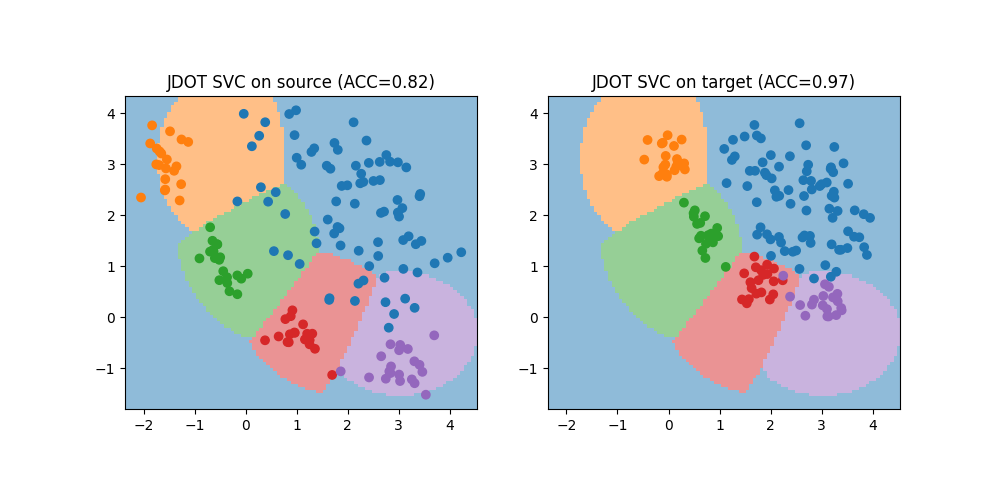
JDOT Accuracy on source: 0.82
JDOT Accuracy on target: 0.97
(np.float64(-2.3676169789533272), np.float64(4.53817259426296), np.float64(-1.7964573229829714), np.float64(4.336863129384494))
Total running time of the script: (0 minutes 1.924 seconds)